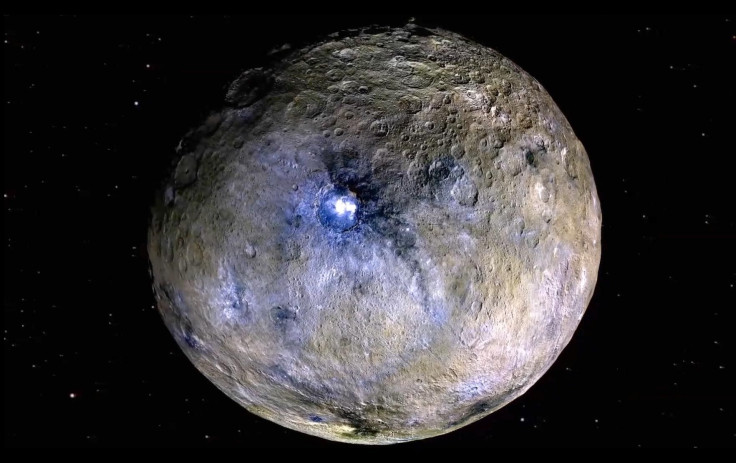NASA’s Dawn Spacecraft Makes Movie Of Dwarf Planet Ceres’ Bright Crater

NASA’s Dawn spacecraft has sent back new images of Ceres, a dwarf planet in our solar system between Mars and Jupiter, that could help scientists understand just what is happening on its surface.
The spacecraft captured Ceres at a point called opposition when it was directly between the sun and Ceres. That spot, 12,000 miles from the dwarf planet, was ideal for it to snap photos of the Occator Crater, the brightest spot on Ceres and one that provides evidence of volcanic activity. NASA weaved those photos into a movie.
“The bright spots of Occator stand out particularly well on an otherwise relatively bland surface,” NASA said.
While the Occator Crater stands out most of all, the whole of Ceres is brighter at opposition, giving scientists a unique perspective from which to study it. According to NASA, that has to do with the size and porousness of the grains of material on its surface.
Read: This Dwarf Planet Is Erupting Salty Stuff
The observations Dawn has sent back could teach astronomers more about Ceres — the largest object in the asteroid belt between Mars and Jupiter — and its composition as they are analyze the information.
Scientists have been investigating Ceres for a while, in part for its potential to hold water and thus host alien life in the form of microbes. Although the dwarf planet looks barren, there is activity there: The Occator Crater is so bright, scientists recently suggested, because a volcano was previously erupting salty material from below its surface, also known as subsurface brine, for millions of years. The material is mostly mineral salts and is younger than other material around it.
That volcano last erupted 4 million years ago, but it’s possible the spot will show cryovolcanic activity in the future — scientists are unsure. Either way, the findings meant Ceres was the closest object to the sun that showed evidence of such cryovolcanism.
Read: Heavy Rain Once Carved “Rivers” on Mars
The research shows it started when a large object crashed into Ceres and forged the crater, triggering the volcano by forcing the salty material closer to the surface and readying it for eruption.
This NASA imaging from the Dawn spacecraft is not the first of Ceres, nor of its famous bright spot. Dawn has been circling Ceres’ neighborhood for the last two years.
The asteroid belt that Ceres calls home, when at its closest point to Earth, is about the same distance from us as the sun, although it is in the opposite direction. At its farthest point, it is double that mileage.
© Copyright IBTimes 2024. All rights reserved.





















